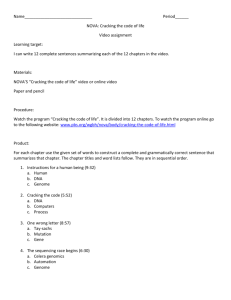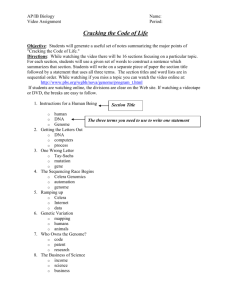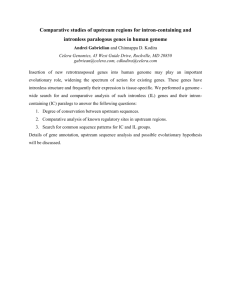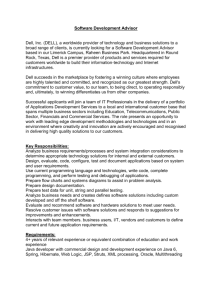IT for Competitive Advantage
advertisement
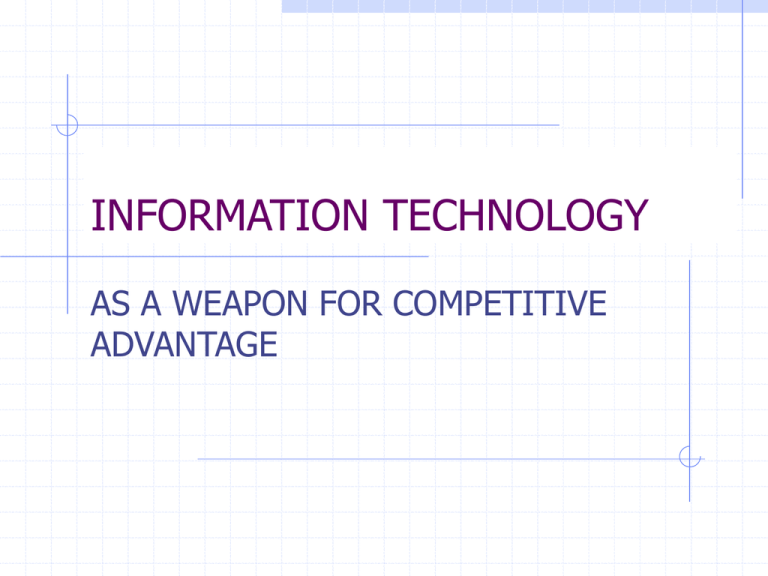
INFORMATION TECHNOLOGY AS A WEAPON FOR COMPETITIVE ADVANTAGE IT’s Influence Within An Organization IT effects revenues and profits in terms of: Helps market segmentation Helpful in increasing market share Allows fast design of new products Better Management Control Better Asset & Liability Management OR Don’t forget IT is also expensive Information Technology as Competitive Advantage Concept Emerged in 1980. Slowly been accepted as valid. Research has shown that very few companies are able to generate a competitive advantage through information technology Feeny, David & Ives, Blake, “IT as a basis for sustainable competitive advantage” in Managing IT as a Strategic Resource, Willcocks, Leslie, Feeny, David (eds). McGraw-Hill Education-Europe, 1997, pp. 43-61 Studies Involving IT as CA How a number of companies successfully deployed their IT weapon for strategic advantage Ex. Eric K. Clemons , Michael Row, “McKesson Drug Company: a case study of Economist—a strategic information system”, Journal of Management Information Systems, v.5 n.1, p.36-50, July 1988 Which are the frameworks that can help managers identify applications that can bring competitive advantage to their own business and the use of such frameworks within the organization Ex. Ives, Blake, Learmonth, Gordon, "The Information System as a Competitive Weapon," Communications of the ACM, Vol. 27, No. 12, December 1984, pp. 1193-1201 Prime question of using IT as CA Can pioneers achieve rewards substantial enough to justify the costs and risks of being prime mover? Subsequent entrants come at much lower costs. This is why you must create switching costs. Feeny, David & Ives, Blake, “IT as a basis for sustainable competitive advantage” in Managing IT as a Strategic Resource, Willcocks, Leslie, Feeny, David (eds). McGraw-Hill Education-Europe, 1997, pp. 43-61 Information Technology as CA Study of Thirty Major Companies Including GE, Xerox, FedEx, P&G 15 firms were able to sustain a competitive advantage in terms of market share or profitability Only 6 were able to sustain both Companies are more likely to fail Kettinger, William, “Strategic Information Systems Revisited: A study in Sustainability and Performance”, MIS Quarterly, vol.18 n.1, pg 31-58, 1994 Examples of Firms That Successfully Used IT American Airlines: SABRE System Baxter: Hospital Supply Systems Mitek: Roofing System UK Telecom: Detailed Customer Billing Fed Ex: Real Time Package Tracking Aligning IT With Business Strategy Contributions Commodity Differentiator Critical Oil Refining SABRE System Useful Payroll ICI Paints The Framework From Feeny And Ives “IT as a Basis for Sustainable C.A.” Sustainable advantage First Pillar How long until Response? Second Pillar Who can Respond? Project Life Cycle Analysis Third Pillar How effective will response Be? Competitor Analysis Supply Chain Analysis Pioneer First Pillar Vision/idea Win approval Project Life Cycle Built •Technology • Application • Database • Knowledge base Discovery Followers Awakening •Awareness •Perceive significance •Accept/assign responsibility Win approval Build Project launch •Enhance Vision/idea Win approval Build etc. •Technology •Applications •Database •Knowledge base Project launch Feeny, David & Ives, Blake, “IT as a basis for sustainable competitive advantage” in Managing IT as a Strategic Resource, Willcocks, Leslie, Feeny, David (eds). McGraw-Hill Education-Europe, 1997, pp. 43-61 First Pillar Project Development Life Cycle Can also be viewed as a sustainability analysis For sustainability, an expensive hard to duplicate system can provide uneven playing field for years of profitability and market growth. Feeny, David & Ives, Blake, “IT as a basis for sustainable competitive advantage” in Managing IT as a Strategic Resource, Willcocks, Leslie, Feeny, David (eds). McGraw-Hill Education-Europe, 1997, pp. 43-61 First Pillar Project Life Cycle Deals with the concept of lead time (Time from launch until substantive response). Anytime you use IT to generate CA, you can expect a response. Feeny, David & Ives, Blake, “IT as a basis for sustainable competitive advantage” in Managing IT as a Strategic Resource, Willcocks, Leslie, Feeny, David (eds). McGraw-Hill Education-Europe, 1997, pp. 43-61 First Pillar Project Life Cycle Four variables of lead time: Awakening Larger the CA, quicker the awakening Win Approval Followers easier to win approval Project Build Does not require vision of prime mover Project launch Feeny, David & Ives, Blake, “IT as a basis for sustainable competitive advantage” in Managing IT as a Strategic Resource, Willcocks, Leslie, Feeny, David (eds). McGraw-Hill Education-Europe, 1997, pp. 43-61 Second Pillar: Competitor Analysis Who Can Respond? Generic lead-time can be made up easily. May even leap frog original system. Therefore a new application that leverages dissimilarities between the prime mover and followers makes it more difficult to mount a response. Feeny, David & Ives, Blake, “IT as a basis for sustainable competitive advantage” in Managing IT as a Strategic Resource, Willcocks, Leslie, Feeny, David (eds). McGraw-Hill Education-Europe, 1997, pp. 43-61 Three Major Areas of Second Pillar 1. Competitive Scope Geographical scope The geographical area that a firm chooses to compete in or locate particular types of work. Segment Scope The breadth of products sold and the buyers served Vertical scope The extend to which the firm has elected to pursue backwards or forward integration strategies Industry scope The range of related industries in which the firm competes with a coordinated strategy. Feeny, David & Ives, Blake, “IT as a basis for sustainable competitive advantage” in Managing IT as a Strategic Resource, Willcocks, Leslie, Feeny, David (eds). McGraw-Hill EducationEurope, 1997, pp. 43-61 Three Major Areas Of Second Pillar 2. Organizational Base Structure Culture Physical Assets Feeny, David & Ives, Blake, “IT as a basis for sustainable competitive advantage” in Managing IT as a Strategic Resource, Willcocks, Leslie, Feeny, David (eds). McGraw-Hill Education-Europe, 1997, pp. 43-61 Three Major areas of Second Pillar 3. Information Resources Technological infrastructure Application inventory Databases Knowledge bases Feeny, David & Ives, Blake, “IT as a basis for sustainable competitive advantage” in Managing IT as a Strategic Resource, Willcocks, Leslie, Feeny, David (eds). McGraw-Hill Education-Europe, 1997, pp. 43-61 Third Pillar: Supply Chain Analysis Will A Response Be Effective? 1.) Find exploitable link- Find point in chain where resources are finite and a limited number of participants control the link. 2.) Capture Pole Position- Create unique relationships • Seek out applications which create unique relationships with that group • In return for benefits, user will put mover in position of preferred partner • Movers continued position is secured against any equivalent offering only superior will justify switching costs. Feeny, David & Ives, Blake, “IT as a basis for sustainable competitive advantage” in Managing IT as a Strategic Resource, Willcocks, Leslie, Feeny, David (eds). McGraw-Hill Education-Europe, 1997, pp. 43-61 Third Pillar: Supply Chain Analysis 3. Keep the gate Closed- Users perceive a significant tangible/intangible cost of switching systems. This is the base for maintaining an advantage • • • Applications- people have to learn interface Database- switching can cause loss of all data gathered and learning of new system Community- A community may form that leads IT to be a part of infrastructure, switching loses this advantage Feeny, David & Ives, Blake, “IT as a basis for sustainable competitive advantage” in Managing IT as a Strategic Resource, Willcocks, Leslie, Feeny, David (eds). McGraw-Hill Education-Europe, 1997, pp. 43-61 Case Studies 1. Celera Genomics Group Presented by: Matt Brickel 2. Dell Computer Corporation Presented by: Kevin Shipley Celera Genomics Group Achievement of Sustainable Competitive Advantage Through the Use of IT? Why Choose Celera Genomics AS A Case Study? In 1998 the principles of the Applera Corporation decided to sequence the Human Genome. At that time the Scientific Community thought it would take 3,000 scientists 15 to 20 years. Celera Genomics did it in 2 years using IT. www.pbs.org/wgbh/nova/genome/deco_venter.html Viewed September 11, 2002 Company Background Established in May 1998 by the PE Corporation and J. Craig Venter, Ph.D Formed to generate and commercialize genomic information. Celera Genomics Group is an operating company of the Applera Corporation, F.K.A. the PE Corp. Dr. Craig Venter Ph.D www.celera.com/company/home.cfm?ppage=overview&cpage=background Viewed October 12, 1992 Size of Celera In Terms of Sales and Profits Celera Genomics Group: Net Revenue 2001: Loss Before Taxes 2001: Net Loss: $ 89,385,000 $232,662,000 $186,229,000 Source: Applera Corporation Annual Report 2001 http://media.corporate-ir.net/media_files/NYS/CRA/reports/2001report.pdf Viewed September23, 2002 Major Products Sold by Celera Celera Discovery System (CDS) CDS is a subscription based web enabled system that allows users access to Celera databases and applications Moving Into Therapeutics Celera plans to begin developing and marketing novel therapeutic drugs identified through its genomic research. www.findarticles.com/cf_bzwr/m0EIN/2000_April_6/61343200/print.jhtml Viewed October 12, 2002 Major Characteristics of Celera Customers 250 International Academic and Commercial Customers Now Use Celera’s Celera Discovery System Some Notable Customers: 1. 2. 3. 4. 5. Pfizer Yamanouchi Pharmaceuticals National Cancer Institute Harvard University University of California System www.celera.com/genomics/home.cfm?ppage=overview&cpage=customers Viewed September23, 2002 Who Does the CIO Report To? Tony White Chairman, President and CEO of Applera Corporation Tama Oliver CIO of Applera Corporation John Reynders, Ph.D Vice President, Information Systems, Celera Corp. Jamie Lacey, Celera Genomics Corporate Communications, interviewed via e-mail by Matt Brickel, September 24, 2002. Celera Executive Management Kathy Ordoñez President, Celera Genomics Mark Adams, Ph.D. Vice President, Genome Programs Werten Bellamy, Jr., J.D. Group Counsel David Block, M.D. Executive Vice President, Celera and Chief Operating Officer, Celera Therapeutics Robert Booth, Ph.D. Senior Vice President, Research & Development Samuel Broder, M.D. Chief Medical Officer Ugo DeBlasi, CPA Vice President, Finance Jason Mollé Senior Vice President, General Manager, Online Business Gene Myers, Ph.D. Vice President, Informatics Research Scott Patterson, Ph.D. Vice President, Proteomics John Reynders, Ph.D. Vice President, Information Systems Bridgette Robinson, A.B.D. Vice President, Human Resources Michael Venuti, Ph.D. Senior Vice President, Research and General Manager http://media.corporate-ir.net/media_files/NYS/CRA/reports/2001report.pdf Viewed September23, 2002 How Many IT Personnel? 50 people are The most recent count shows that employed in an IT capacity at Celera. Jamie Lacey, Celera Genomics Corporate Communications, interviewed via e-mail by Matt Brickel, September 24, 2002. What is Celera’s Annual IT Budget? Celera does not disclose information pertaining to IT budget. In 2001 Celera Spent $164,693,000 on research and development. http://media.corporate-ir.net/media_files/NYS/CRA/reports/2001report.pdf Viewed September23, 2002 Description of the Critical Differentiator Celera’s process uses robots that conduct polymerase chain reaction PCR processes to magnify and read DNA chains. http://allserv.rug.ac.be/~avierstr/principles/pcrani.html 300 robots @ $300,000 each = $90,000,000 Each rung on the DNA chain contains 2 out of 4 possible letters; A, G, C or T Human Genome is 3 billion letters www.pbs.org/wgbh/nova/genome/deco_venter.html Viewed September 11, 2002 Description of the Critical Differentiator Celera’s computer’s hard drive has 100 terabytes of data 1 terabyte = 1,000 gigabytes 1 gigabyte = 1,000 megabytes Perspective, my new Dell computer has a 40 gigabyte hard drive X 2,500 = Celera Hard Drive Capacity www.pbs.org/wgbh/nova/genome/deco_venter.html Viewed September 11, 2002 Description of the Critical Differentiator Celera uses a network of computers to process the data from the hard drive Each computer has 4 alpha chips in it 20,000 CPU hours to decode the Human Genome One CPU hour = Use of 1 Alpha Chip for 1 Hour Celera decoded Human Genome in one shift! www.pbs.org/wgbh/nova/genome/deco_venter.html Viewed September 11, 2002 Celera Discovery System Overview “The Celera Discovery System is an integrated, easy to use, web-based discovery platform that combines the most comprehensive set of genomic and biological data along with powerful visualization and analysis tools. It allows researchers to search, analyze, interpret and manage their genomic information in one place thus saving valuable time, reducing costs and accelerating their research.” www.celera.com/genomics/academic/home.cfm?ppage=cds&cpage=default Viewed October 12, 2002 History of the system: • In 1998 the principals of Applera Corporation decided to sequence the human genome. • The thinking at the time, by people outside of Applera Corp., was that it would take 3,000 scientists 15 to 20 years to sequence the human genome. • The people at Applera thought that it could be done by 2002 using information technology. • They formed Celera Genomics group to begin the process. • They had an idea that they could use Robots to automatically conduct PCR processes but they had to build them first. • Applied Biosystems, Celera’s sister company, built the robots from scratch. www.pbs.org/wgbh/nova/genome/deco_venter.html Viewed September 11, 2002 History of the system: • The building of these robots was the impetus for the genome race. • Once the robots were built to perform and read the information derived from the PCR processes, Celera had to find computers to store the data and then process it (sequence the Genome). • Once the system was assembled Celera started out by sequencing the genome of simple organisms that had already been sequenced so that they could verify that it worked. • They then sequenced the mouse genome, and then they sequenced the human genome in 2000. • Shortly thereafter the Celera Discovery System was launched and in 2001 the current advanced version was launched. www.pbs.org/wgbh/nova/genome/deco_venter.html Viewed September 11, 2002 Was the System Designed for Competitive Advantage Or Was It a Surprise? The people at Celera had the idea that they could sequence the human genome faster than was thought possible at the time. Nobody new for certain that it was going to work. Dr. Craig Venter was quoted as saying: “I am not afraid to take risks. I mean I said at the beginning that either this would be one of the most spectacular success stories in history or the biggest flame-out in history. There was clearly a risk element to this. In fact, when I look at all the things that could have failed and could have gone wrong, its stunning perhaps that it did work as well as it did.” www.pbs.org/wgbh/nova/genome/deco_venter.html Viewed September 11, 2002 Was the System Designed for Competitive Advantage Or Was It a Surprise? Essentially Celera is not worried about others replicating what they have done because there is really no need to do so. Celera willingly shares the information that they have for a subscription fee. In the case of Pharmaceutical companies the fee is negotiated and is in the millions of dollars. For academic researchers there is a pricing schedule: www.pbs.org/wgbh/nova/genome/deco_venter.html Viewed September 11, 2002 Was the System Designed for Competitive Advantage Or Was It a Surprise? CDS pricing schedule: Number of User(s) (1 year term) Additional Cumulative Annual User Fee Per User+ Per User $30,000 each Number of User(s) (3 year term) Additional Cumulative Annual User Fee Per User* 1-5 Users $17,000 each 6 - 10 Users $15,000 each 11 - 25 Users $12,000 each 26 - 55 Users $11,000 each 56 - 75 Users $10,000 each 76 - 100 Users $ 8,500 each 101 - 250 Users $ 7,000 each +Basic subscription (Human Reference SNP Database not included) *All fees should be calculated based on a 3-year term (Human Reference SNP Database not included). www.celera.com/genomics/academic/home.cfm?ppage=pricelist&cpage=default, Viewed Oct. 12, 2002 How Do Customers Interact With the System? The Celera Discovery System (CDS) is a web based tool that is accessed through www.celera.com. They can use the information available there to conduct their own research which can be saved on the customers computers behind their own firewall. Does Celera’s Use of IT Give Them a Sustainable Competitive Advantage? Pillar 1: Project Life Cycle analysis: How long until a response? • • • • Awakening Approval Building the System Project Launch The time it would take the government to respond would likely be substantial and its effectiveness uncertain. Celera’s competitive advantage is supported by the first pillar. Does Celera’s Use of IT Give Them a Sustainable Competitive Advantage? Pillar 2: Competitor Analysis: Who can respond? •Competitive Scope •Organizational Base •Information Resources As stated previously the most likely competitive response would come from the US Government. The government does not have the competitive scope that Celera has. They do not have the necessary organizational base. They do not have the necessary information resources assembled. Celera’s competitive advantage is supported by the second pillar. Does Celera’s Use of IT Give Them a Sustainable Competitive Advantage? Pillar 3: Supply Chain Analysis: Will Copying Help? Supply Chain Analysis: Will Copying Help? •Find Exploitable Link •Capture Pole Position •Keep the Gate Closed Even if the government copies what Celera has done it is unlikely that Celera’s customer base will switch. Overall Conclusion Celera’s systems provide a sustainable competitive advantage that is supported by the three pillar model. Dell Computer Corporation Enabling business processes through information technology? Company Background Founded in 1984 by Michael Dell Started selling computers out of his dorm room Started by building computers with components made by other companies to meet customers needs. This became the basis for Dell’s direct-model Today, Dell is valued at over 26 billion dollars Size of Dell In terms of Sales and Profits Dell Computer Company: Net Revenue February 2002 2001 2000 $31,168 $31,888 $25,265 2002 2001 2000 $1,246 $1,777 $1,666 Net Income February Dell Annual Report February 2002 Major Products Sold by Dell Enterprise Systems servers and storage Network switches and workstations Notebook and Desktop computers Peripheral Products Various services and technical support Major Characteristics of Dell’s Customers The companies customer’s range from large corporations, government agencies, healthcare institutions, small businesses, and individual consumers No customer represents more than 10% of business Range from relational to transactional More than $3 million a day in internet sales Most sales to business or government(>70%) Shell, Exxon, MCI, Ford, Toyota, Boeing Greater than 30% of sales from foreign customers www.mhhe.com/business/management/thompson/11e/case/dell5. html Dell’s Chief Information Officer Randy Mott, former CIO of Wal-Mart Reports To Michael Dell Oversees more than 20 strategic and over 100 other major projects at any given time Consults with executive team and oversees eight direct subordinates Constantly meets with customers to understand customer and sales force needs Challenge is to make sure department uses the right systems to support Dell’s model. Worthen, Ben.: “Travelin’ Man.” CIO Magazine. Mar1, 2002 Dell’s IT Department More than 2,500 IT personnel Uses Cross-Functional Teams Global Matrix Team 250 members Ensure that Dell website functions correctly Find enterprise solutions to help Improve Productivity Worthen, Ben.: “Travelin’ Man.” CIO Magazine. Mar1, 2002 What is Dell’s IT Budget? Not Available Research Development and Engineering Costs February 2002 $452 February 2001 $482 February 2000 $374 Dell Annual Report February 1, 2002 Description of the Critical Differentiator Dell’s Direct Model Manufacture of Components by suppliers Purchase by Users Customized Assembly Service And Support Critical Differentiator Advantages of Dell’s Direct Model Eliminated time and costs of distributing through independent retailers. Eliminated need for various computer models No longer need to discount slow selling PC’s before new models are introduced Eliminated Mark-Ups. www.mhhe.com/business/management/thompson/11e/case/dell5.html, October 16 2002 Critical Differentiator Supply Chain Management Dell manages the relationships from the original supplier to the end customer. ‘Supply chain management shortens the cycle between the component, the manufacturer and the end customer. We are allowing them to almost touch each other.’ –Michael Chong, Tech. Mgr. Dell looks for opportunities to cut costs throughout the process. Shaving .1% off materials costs has a bigger impact than a Ten percent raise in manufacturing productivity ---. “How Dell Keeps from stumbling”. Business Week. May 14, 2001, page 38b ITAC online Dell case study, see reference Critical Differentiator IT’s Role in the Supply Chain Dell uses information technology to continually refine the supply-chain to remain the low cost producer. Key Components: i2 suite software Valuechain.dell.com Dell.com XelusPlan Critical Differentiator i2 Suite Software Implemented in 1999 Planning i2 TradeMatrix Supply Chain Planner i2 TradeMatrix Buy Solution Execution i2 TradeMatrix Factory Planner Rhythm Collaboration Planner Critical Differentiator i2 Suite Software “On the planning side, we decided to use the i2 TradeMatrix Supply Chain Planner and i2 TradeMatrix Buy Solution software to communicate our materials requirements to suppliers. On the execution side, we're deploying the i2 TradeMatrix Factory Planner and Rhythm Collaboration Planner to schedule our factories and communicate materials requirements to the supplier hubs," - Eric Michlowitz, Dell’s director of Supply Chain http://www.dell.com/us/en/gen/casestudies/casestudy_dell_i2.htm, October 16, 2002 Critical Differentiator i2 Suite Software Advantages Enhances efficiency of the pull system Only .05% of costs to obsolete inventory Precise delivery of components Can specify what door and what time components arrive Orders arrive exactly when needed Factory has five to six hours worth of inventory Allows for order prioritization Three times the number of units per square foot ---. “How Dell Keeps from stumbling”. Business Week. May 14, 2001, page 38b Critical Differentiator i2 Suite Software Advantages “It was important for us to have a global view of Dell's entire supply chain. We wanted to be able to see - on a real-time basis - what materials are available at the supplier hubs, what suppliers have committed to worldwide and what demands they haven't been able to support." Michlowitz http://www.dell.com/us/en/gen/casestudies/casestudy_dell_i2.h tm October 16, 2002 Critical Differentiator ValueChain.Dell.Com Secure extranet that allows suppliers to collaborate in managing the supply chain Provides suppliers with the ability to drop off invoices, check engineering change orders, cost reports, and overall performance. Allows suppliers to more accurately forecast future demand. ITAC online Dell case study, see reference Critical Differentiator ValueChain.Dell.Com Enhances Supplier relations Number of Suppliers has dropped from 1,000 to 100 90 percent of Material Supplies purchased online Suppliers are more likely to collaborate Color of monitor example Critical Differentiator Dell.com Converted to XML in 1999 Uses eXcelon Redesign uses customerization Takes into account local factors Remembers product purchased Reaches 80 countries with 22 different languages Maintains 20,000 pages in service section alone http://www.wdvl.com/Authoring/Languages/XML/Conferences/XML99/ dell.html October 16, 2002 Critical Differentiator XelusPlan Service logistics program “XelusPlan allows us to forecast, plan, and track forecast accuracy against actual demand. It provides us with a single, centralized database and standard planning procedures.” –Don Smith, business analyst Focuses on service organization More than 6,000 orders a day http://www.xelus.com/CaseStudies/cs_dell.asp, October 16, 2002 Critical Differentiator XelusPlan Advantages Quickly process orders Use scenario analysis Appropriately adjust inventory levels to maintain proper service levels In continuously changing environment allows Dell to forecast demand for both new and old components http://www.xelus.com/CaseStudies/cs_dell.asp October 16, 2002 Reasons IT generates a Competitive Advantage Cuts materials costs Materials cost account for greater than $21 billion More than 70% of revenue spent on materials Reduces inventory levels and cycle time Very little obsolete products Reduces transaction costs Most transactions occur online Shah, Jennifer. “Dell writes the book on efficiency.” EBN. Dec 17,2001. pg32 Reasons IT generates a Competitive Advantage “Putting Technology behind the Supply Chain process has also provided a gateway for greater efficiencies, facilitated Communications with suppliers, and improved operations between internal groups” Jennifer Shah, EBN Shah, Jennifer. “Dell writes the book on efficiency.” EBN. Dec 17,2001. pg32 Does Dell’s use of IT Give Them a Sustainable Competitive Advantage? Pillar 1: Project Life Cycle: How Long Until Response? Awakening Approval Building the System Project Launch Dell’s system is largely internal and complex. This makes it hard for the competition to build and introduce a similar product. Does Dell’s use of IT Give Them a Sustainable Competitive Advantage? Pillar 2: Competitor Analysis: Who can respond? Competitive Scope Organizational Base Information Resources Competitors were too vertical and had too many products. Structure, cultures, and physical assets were geared toward other system Competitors had investments in current inventory methods and technological infrastructures www.mhhe.com/business/management/thompson/11e/case/dell7.html October 16, 2002 Does Dell’s use of IT Give Them a Sustainable Competitive Advantage? Pillar 3; Supply Chain Analysis: Will Copying Help? Find Exploitable Link Capture Pole Position Keep the Gates Closed Found points in supply chain where participants control the link, created unique applications that encourage strong relationships with suppliers and customers, found ways to ensure that suppliers and customers will continue to be loyal to Dell. Dell Conclusion Dell uses IT to: Enable its business model Create a sustainable competitive advantage over its competitors. Conclusion IT is important to an organization because it effects profits, revenues, and a company’s business systems IT can be used to create a sustainable competitive advantage Companies can succeed by following certain rules regarding the use of IT More companies fail than succeed Effective Use of IT Celera’s System Meets the Criteria Set Forth by the Three Pillars Model Project Life Cycle Analysis Competitor Analysis Supply System Analysis Effective Use of IT Celera Genomics Group Celera Genomics Group Used IT To: Develop a ground breaking system enabling users to perform accelerated genome research Research institutions do not have to invest the vast amounts of capital required to perform this type of research The genome of any organism can be mapped Will aid in the discovery of new medicines and therapies Create a new business niche Automated genome mapping and research at previously impossible speed Effective Use of IT Dell’s System Meets the Criteria Set Forth by the Three Pillars Model Project Life Cycle Analysis Competitor Analysis Supply System Analysis Effective Use of IT Dell Computer Dell used IT to: enable its business model enhance business processes Manage its supply chain Better supplier relations Real-time management Forecast and respond to demand Reduce Inventories Improve customer relations Lessons for the CIO Factors in the Success of IT Complexity of system Switching costs Dissimilarities between prime mover and competition Use of exploitable link Customers understand system Lessons for the CIO Make a complex system that is hard to replicate Companies had CIO’s that were valued by their organization Companies viewed IT as an important part of creating a competitive advantage Lessons for the CIO Used weaknesses of their competitors to leverage dissimilarities Captured the Pole Position Found ways to deter customers from switching to a competitor Used the right system Information Technology as Competitive Advantage Questions http://www.itac.ca/client/ITAC/ITAC_UW_MainEngine. nsf/cd0bbbe7b8237e1e85256482005b6998/6baed26b b718c58f85256a23004d7688!OpenDocument 10/17/02 Additional References 1. • • • • http://www.itac.ca/client/ITAC/ITAC_UW_MainEngine.nsf/cd0bbbe7b8237e1e85256482005b6998/6 baed26bb718c58f85256a23004d7688!OpenDocument 10/17/02 Blau, John, “E.U mulls How To Boost Its R&D” Research Technology Management, Vol. 45, Sept./Oct. 2002, pp. 5-6. Thackray, John, “Bioinformatics Grows Legs” Electronic Business; Highlands Ranch, Vol. 27, July 2001, pp. 76-82 Mearian, Lucas and Weiss, Todd R., “HP User Defects; EMC, IBM Score” Computerworld; Framingham, Vol. 36, Sept. 30, 2002, pp. 1,16 Anonymous, “Tech Quarterly: Microchips In the Blood” The Economist, Vol. 364, Sept. 21, 2002, pp. 7
